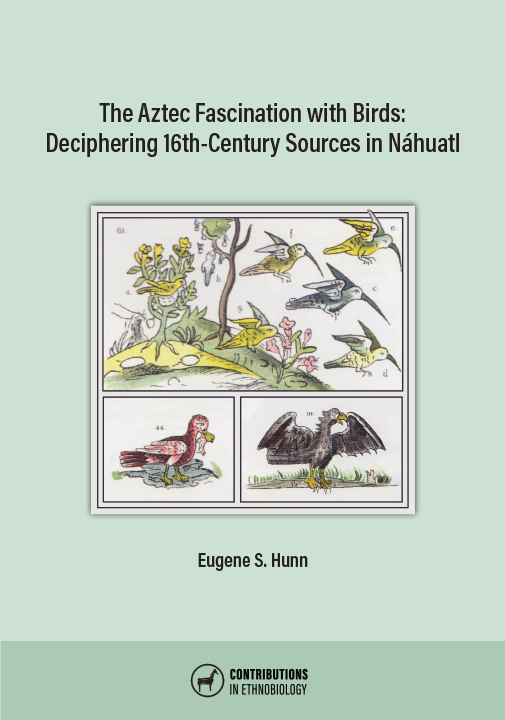The Aztec Fascination with Birds: Deciphering 16th-Century Sources in Náhuatl

The Aztec Fascination with Birds: Deciphering 16th-Century Sources in Náhuatl
By Eugene S. Hunn
Available in electronic or print versions.
Print: USD$50.00* Buy now
When you click on the "Buy now" link above, you will be directed to Amazon.com.
Electronic (PDF download):
• Members: LOG IN to access your $10 DISCOUNT code.
• Non-Members: USD$25.00 PDF download (see below)
*All proceeds go directly to the Society of Ethnobiology to support future publications.
The Aztec Fascination with Birds’
Digital Collection of Images and Sounds
Scan or click on the QR code below to access the digital collection.
Abstract: The Aztec empire was established in the Valley of Mexico in the 14th century, eventually dominating a vast region from a base on their island capital city, Tenochtitlán. Hernán Cortés sacked Tenochtitlán for Spain in 1521. Missionary friars arrived soon after to begin the Christianization of the Mesoamerican population. To facilitate their conversion, Franciscan scholars trained the descendants of the Aztec nobility in alphabetic writing. Indigenous students/colleagues soon mastered written Latin and learned to write their native Náhuatl. Fray Bernardino de Sahagún organized a complex ethnographic enterprise employing Indigenous colleagues to compile an encyclopedia of Indigenous Aztec knowledge. This work survived in Spanish translation as the Historia General de las Cosas de Nueva España and was subsequently published with parallel Náhuatl and English texts as the Florentine Codex. Book 11 of the Codex is devoted to “Earthly Things” of which the “Second Chapter,…telleth of all the different kinds of birds.” Over 130 are named and described and illustrated in varying detail. However, establishing the correspondence of these birds with our contemporary ornithological inventory of Mexican birds has been a challenge. The Mexican biologist Martín del Campo published an analysis based on the Spanish version in 1940, and his suggested identifications have been treated as definitive. I have reviewed the evidence in light of contemporary knowledge and offer here a refined analysis of the probable identities of the birds named in the Codex with a detailed rationale. This material offers rich insights into a Mesoamerican traditional natural history.
Eugene S. Hunn (PhD, University of California, Berkeley, 1973) is Professor Emeritus in Anthropology at the University of Washington, Seattle. His research and writing have been devoted to documenting traditional environmental knowledge by Native Americans throughout North America, combining academic interests in the nature of human knowledge and its expression in language with a fascination with natural history. His books include Tzeltal folk zoology: the classification of discontinuities in nature (Academic Press, 1977), Resource managers: North American and Australian hunter-gatherers, co-edited with N.M. Williams (Westview, 1981), Nch’i-Wána “The Big River”: Mid-Columbia Indians and their land, with James Selam and Family (University of Washington Press, 1990) and A Zapotec natural history: trees, herbs, and flowers, birds, beasts, and bugs in the life of San Juan Gbëë (University of Arizona Press, 2008).
- Imperial Aztec Ethno-Ornithology: Introduction
- Who Were the Aztecs?
- Ethnobiology
- The Method in My Madness
- The Birds of the Florentine Codex Deciphered
- “First paragraph,” Birds with Rich Plumage
- “Second paragraph,” Parrots, Hummingbirds, and Others
- “Third paragraph,” The Waterfowl
- “Fourth paragraph,” The Birds of Prey
- “Fifth paragraph,” Miscellaneous Birds
- “Sixth paragraph, which telleth of still other kinds of birds,” but is, in fact, limited to the quail
- “Seventh paragraph, which telleth of still other birds, of their habits”
- “Eighth paragraph, which telleth of the birds which are good singers”
- “Ninth paragraph, which telleth of the native turkeys”
- “Tenth paragraph, which telleth of the parts of the different birds”
- Discussion
- Cultural Values of Birds
- Birds for Food
- Bird Voices
- Birds as Omens, Medicines, and Cultural Icons
- The Aztec Ornithological Taxonomy
- How are Birds Named?
- What’s Missing?
- Cultural Values of Birds
- Conclusions
- Appendix 1: Náhuatl Bird Names from Other Sources
- Appendix 2: Taxonomic Structure in the Structure Shown in the Nomenclature or in the Paragraph Headings
- Appendix 3: Bird Names Incorporating TŌTŌ-TL/TŌTŌ-MEH (Bird/Birds)
- Appendix 4: Some Modifying Attributives
- Appendix 5: Onomatopoetic or Sound Symbolic Names (N = 24)
- Appendix 6: A Comparison of the Identifications of Martín del Campo (1940) with those of Hunn (2023)
- Permissions
- References Cited
- Index of English and Latin Bird Names
- Index of Náhuatl Bird Names
- Subject Index
File Downloads
| Price (USD) | |||
|---|---|---|---|
|
|
The Aztec Fascination with Birds: Deciphering 16th-Century Sources in Náhuatl |
USD$25.00 |

